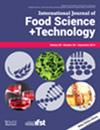Comparative analysis of kokumi tastant intensity from mechanically deboned meat across three species through in vitro calcium‐sensing receptor activity
IF 2.6
3区 农林科学
Q2 FOOD SCIENCE & TECHNOLOGY
引用次数: 0
Abstract
SummaryThe emergence of kokumi sensation as a flavour enhancer prompted the search for cost effective and the sustainable production of kokumi flavour substances (KS), including small γ‐glutamyl peptides (GGP) and aromatic free amino acids (FAA). We sought to investigate the potential of mechanically deboned meat (MDM) from beef, mutton, lamb and venison for KS production through enzymatic γ‐glutamylation. Liquid chromatography‐mass spectrometry (LC–MS) and通过体外钙传感受体活性比较分析三个物种机械去骨肉的 Kokumi 味觉强度
摘要作为一种增味剂,Kokumi 香味的出现促使人们寻找具有成本效益和可持续生产的 Kokumi 香味物质 (KS),包括小的γ-谷氨酰肽 (GGP) 和芳香游离氨基酸 (FAA)。我们试图研究牛肉、羊肉、羊肉和鹿肉的机械去骨肉(MDM)通过酶法γ-谷氨酰化生产 KS 的潜力。液相色谱-质谱法(LC-MS)和体外钙感受体(CaSR)活性测定法分别用于鉴定 GGPs 及其 Kokumi 强度。酶解法明显增加了所有 MDM 样品中的 GGP 和 FAA,但不同物种中的单个肽存在差异。值得注意的是,所有四种来源的 MDM 都能以剂量依赖的方式激活 CaSR,并显示出不同的效力和功效水平。牛肉、羔羊肉和羊肉显示出相似的较高效力范围,而鹿肉则显示出较低的效力,但效力较高。作为示例,γ-谷氨酰化牛肉样品在 80 ℃、120 ℃ 和 150 ℃ 的温度下具有热稳定性。鉴于这些发现,MDM 是一种很有前景的 KS 生产基质,值得进一步研究,以评估其在食品工业中增强 Kokumi 风味的实际应用性。
本文章由计算机程序翻译,如有差异,请以英文原文为准。
求助全文
约1分钟内获得全文
求助全文
来源期刊
CiteScore
5.80
自引率
9.10%
发文量
655
审稿时长
2.9 months
期刊介绍:
The International Journal of Food Science & Technology (IJFST) is published for the Institute of Food Science and Technology, the IFST. This authoritative and well-established journal publishes in a wide range of subjects, ranging from pure research in the various sciences associated with food to practical experiments designed to improve technical processes. Subjects covered range from raw material composition to consumer acceptance, from physical properties to food engineering practices, and from quality assurance and safety to storage, distribution, marketing and use. While the main aim of the Journal is to provide a forum for papers describing the results of original research, review articles are also welcomed.

 求助内容:
求助内容: 应助结果提醒方式:
应助结果提醒方式:


